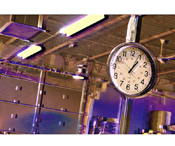
|
|
The History of TPM

TPM or Total Productive Maintenance is a Japanese idea that can be traced back to 1951. This is the year when preventive maintenance was first introduced into Japan, from the United States. Nippondenso, (part of Toyota), was the first company in Japan to introduce plant wide preventive maintenance in 1960.
|
|
The fundamentals of preventive maintenance are that operators produced goods using machines, and the maintenance group was dedicated to the work of maintaining those machines. However, with the high level of automation of Nippondenso, maintenance became a bigger and bigger problem, so many more maintenance personnel were now required. Because of the scale of the problem the management decided that the routine maintenance of equipment would now be carried out by the operators themselves (this is autonomous maintenance, one of the features of TPM). The maintenance group would then focus only on "maintenance" works for upgrades.
The maintenance group would focus on performing equipment modification that would improve its reliability. These modifications were then made or incorporated, into new equipment. The focus of the work of the maintenance group is then to make changes that lead to maintenance prevention. Thus preventive maintenance along with maintenance prevention, and maintainability improvement, were grouped as productive maintenance. The goal of productive maintenance was to maximize plant and equipment effectiveness, to achieve the optimum life cycle cost of production equipment.
This was easier for Nippondenso to implement, since they already had quality circles which involved the employees in changes. Once TPM was implemented all employees took part in implementing productive maintenance. Based on these changes Nippondenso was awarded the distinguished plant prize for developing and implementing TPM, by the Japanese Institute of Plant Engineers (JIPE). Nippondenso of the Toyota group became the first company to obtain the TPM certifications. The practice has become widespread in the manufacturing world today.
TPM can be considered a new way of looking at maintenance, or conversely, a reversion to old ways but on a mass scale. When using TPM the machine operator performs much, and sometimes all, of the routine maintenance tasks themselves. This auto-maintenance ensures appropriate, and effective efforts, are expended since the machine is wholly the domain of one person or team. Companies, who are committed to Total Productive Maintenance, find that they experience less downtime, waste and higher productivity.
After TPM, the focus was stretched even further, with suppliers and customers becoming involved.The next step in methodology was called lean manufacturing. This methodology was simply adding on to TPM in its original form. TPM is considered a critical adjunct to lean manufacturing. This is because if machine up-time is not predictable, and if process capability is not sustained, the process must keep extra stocks to buffer against this uncertainty, and flow through the process will be interrupted.It is important to understand that an accurate and practical implementation of TPM will increase productivity within the total organization, where the following factors are found:
- A clear business culture that is designed and committed to continuously improve the efficiency of the total production system
- A business organization that has a standardized and systematic approach where all losses are prevented and/or known, a method of record keeping is consistently used.
- A company culture where all departments, influencing productivity, will be involved to move from a reactive to a predictive mindset.
- A commitment to move toward a transparent multidisciplinary organization that is reaching zero losses.
- Management that understands that steps are taken as a journey, not as a quick menu.
It has been clearly shown that Total Productive Maintenance can provide practical and transparent ingredients that can help businesses of any size reach operational excellence.
Privacy Policy, Terms of Use